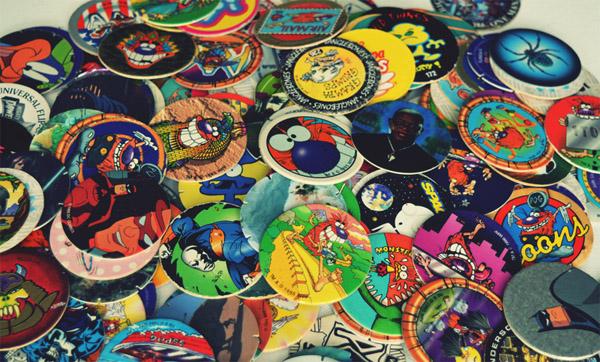
During the neon-colored haze of the late eighties and nineties, among many new toys and gadgets flooding the marketplace, there was one that stood out as the toy that every kid wanted – pogs, and everyone wanted them! But they had been popular once before; another set of cool kids had wanted to collect them, too, or at least something very similar. Remember milk bottle caps? They were basically the same thing! A lot of older kids thought they were seeing a comeback remake of their old fave, but were they right? Is that really how pogs got their start? Did the idea for pogs come from milk bottle caps? Yes and no! They actually began as something kind of useful.
Pog History
Pogs can actually trace their some of their original history back around two hundred years! Unbelievable, right? Well, the actual game-play that ended up as pogs can be traced way back to Menko, a classic Japanese game that first became popular during the Edo Period, which took place between 1603 and 1867. Menko was comprised of players who attempted to flip the cards or their opponent’s pieces.
The original playing pieces were a lot like modern pogs. They were around the size of milk caps and wrestlers and warriors of Japanese culture were the featured images upon them. However, the pieces weren’t made out of plastic or cardboard, but were shaped from ceramics, wood, or clay (although, Menko later did include pieces made of cardboard which are considered to be the ancestors of trading cards.)
Menko was then brought by Japanese immigrants to the US, first in Hawaii, in the beginning of the twentieth century. Imaginative kids began using milk bottle caps for playing pieces. After all, the milk caps were the right size and stiff enough for play and the evolution of Menko began.
From Hawaii With Love
Menko became one of the Hawaiians most favorite games; they had been playing it for decades. In fact, one of the Hawaiians was the woman who helped transform the game into one of the hottest fads of all times. Blossom Galbiso, a teacher, reintroduced the game to the world in 1991 by teaching it to her class, showing them how much fun her childhood game had been and still could be.
Galbiso actually favored her classes playing the game because she thought it helped to improve their math skills. In addition, she also liked the fact that it provided the children with something fun to do that didn’t include any type of potentially dangerous play, like dodge-ball, which was also very popular at the time.
Galbiso and her class began collecting milk bottle caps for the sole purpose of gaming. They especially liked getting the ones on Maui from Haleakala Dairy. The more they played, the more the game began spreading around the islands and soon, the company making the caps found themselves swapped with requests for extra caps. By 1993, the game was going places, hitting the mainland in the West before traveling across the US, first taking it by storm, and then the rest of the world. Just like other quick fads, it dominated over pretty much everything.
Playing the Game
Even though it may look like a bunch of random slapping and throwing, playing pogs is much more involved than that, although that’s probably what it looked like at any middle school during lunch. Actually, like the original game of Menko, the object of the game was to flip your opponent’s pieces. Most battles were for keeps, with the winning player getting to keep all the pogs. Facing off consisted of players ponying up the same amount of pogs, placing them face down in a large stack. The player who goes first, takes aim, shoots, and slaps down the slammer on the stack. If a pog flies out and lands face up, it’s theirs to keep. Players would keep specialty or collector’s pogs out of games to keep from losing them, but they still liked showing off special pogs.
Pog Juice
What you may not know is that pogs first sprang from a popular Hawaiian brand of juice right around the same time the teacher Galbiso and her students were beginning to make the game popular once more. POG juice was named for its main ingredients: passion fruit, oranges, and guava, and just like the classic milk bottle caps, the tops of the POG juice containers were flat, round, and made of cardboard. Guess which company capitalized on making POG juice and starting the pog fad? The Haleakala Dairy, who had originally been swamped with requests for milk bottle caps!
However, as the game play progressed, players began needing something stronger than the cardboard tops. They were just not tough enough. Players wanted pogs that were tougher, stronger-made, and cooler looking and, of course, better for flipping. This is where slammers came in. Slammers were made of plastic, rubber, or metal instead of cardboard. The more they evolved, the more their imagery did as well.
The World POG Federation
Alan Rypinski, who was considered to be a forward-thinking businessman, saw pogs for what they could become as the craze swept the islands and he bought the POG trademark from the dairy company. He then found the World POG Federation (WPF). Like a lot of products that end up being called by a brand name (like Chapstick or Kleenex, even when it’s another brand) everyone called pieces “pogs” even if they were official pieces. This was mostly in part to WPF, which started tournaments, minting Pogman as their mascot, and decorated their own pog products with culturally relevant images in awesome looking graphics, making them even more irresistible to kids.
Pogs Everywhere
Pogs popularity swept the nation and the world, becoming the go-to delivery service for every kind of image imaginable. Not just cool sports, toys, and movies, but also famous places and important people; even Bill Clinton got his face on a pog! Pogs also became popular with more altruistic goals in mind, such as fire safety, drug prevention, and for bringing awareness to charitable organizations. If you could fit it on a pog, it was going on a pog!
Pogs became available at not just comic book shops and toy stores, but they also became solid promotional items as well. All the major fast food chains jumped on the bandwagon, giving out pogs in their kids meal, or offering special addition pogs “free with purchase”. Others became “ad pogs” for everything from amusement parks to gaming systems to drink mixes to pretty much anything purchasable. It was a phenomenal fad and everyone could enjoy it; it wasn’t just for game-play anymore.
Ban Beginnings
Because there was so much game playing going on at school when kids were supposed to be learning and/or distracting from class, teachers, administrators, and even parents were beginning to get fed up with pogs. Pogs was essentially akin to kid-gambling; it kept students distracted and even sparked fights at recess, lunch, and after school. Schools all over the world began banning pogs from school grounds, including the US, effectively beginning the end of the pog craze.
In fact, by the mid nineties, bans didn’t even need to exist anymore. As quickly as they rose to fame, they died out, like so many timely fads. Do you still have your pog collection? There are still some pretty cool vintage pogs around and you never know, they may even make a comeback sometime. Time will tell!
 Follow Us
Follow Us




